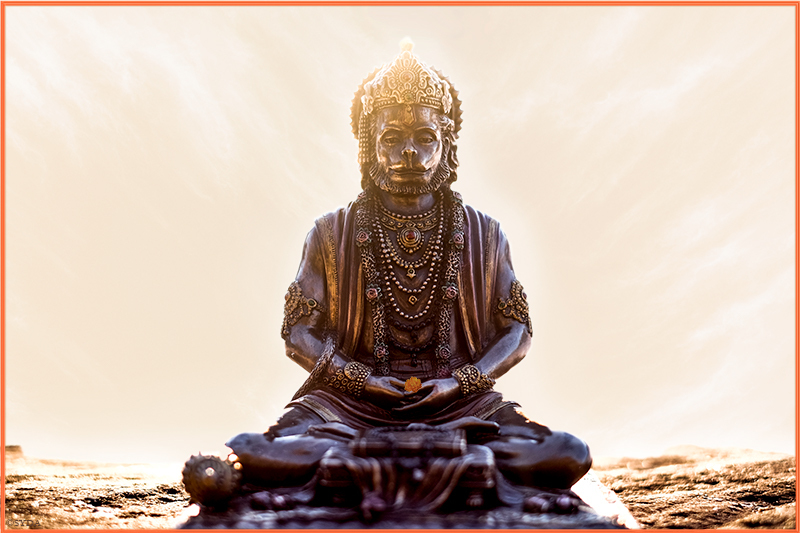Shri Hanuman, the Great Warrior, the Ardent Devotee


Introduction by Morgan Hooper
Gracing the sacred grounds and temples at Gurudev Siddha Peeth and Shree Muktananda Ashram are statues of Hanuman, the noble disciple of Lord Rama. Sculpted to capture Hanuman’s mighty form, these images depict him in tadasana, the mountain pose. His great muscular physique is relaxed and light. His long tail is alert, almost playful. Resting easily on his right shoulder is his gada, his battle mace. His warm, beneficent gaze seems to simultaneously look toward the horizon and yet also take in the seekers beholding him in wonder. To meet Shri Hanuman is to have darshan of the greatest bhakta, the bravest warrior, and the humblest servant of the Lord.
On the Siddha Yoga path, Shri Hanuman is invoked for protection, courage and blessings. Shri Hanuman is also revered for his exemplary virtues. Bravery, service, magnanimity, surrender, playfulness, knowledge of the ancient scriptures, and steady wisdom—these are some of his shining qualities worthy of being emulated. Most of all, Hanuman is regarded as the epitome of devotion and loyalty to the Guru.
Shri Hanuman, son of Vayu, god of the wind, plays a central role in the Ramayana, the ancient Indian epic depicting the life of Lord Rama and his mission to restore dharma to the earth. In this tale, Rama must rescue his wife, Sita, from the clutches of the demon Ravana, and while on this journey the Lord encounters Shri Hanuman of the vanara, or monkey clan. This mighty monkey is capable of such unfathomable feats that he sometimes leaves even the Lord himself in awe. Hanuman is strong and quick, able to leap over any expanse and transform into any shape he wishes.
Upon meeting Rama, Hanuman instantly recognizes him as the beneficent Lord, and learning of Sita’s abduction, pledges to find her for him. Pleased with Hanuman’s devotion, Lord Rama agrees and sends him on a scouting mission. Hanuman eventually discovers Sita in Ravana’s fortress on the island of Lanka. Undeterred by the countless demons that surround them, Hanuman offers to fight off all perils and carry Sita on his back to safety. Sita graciously declines, knowing that even though she is in jeopardy, there is something greater at stake—the restoration of harmony to all humanity. The only way for this to be accomplished is for Lord Rama to confront and defeat Ravana.
Shri Hanuman obeys the wishes of his Lord Rama and Mother Sita as he reverentially addresses the Goddess, and, in this way, demonstrates not only his power but also his humility and his obedience to God’s command. Serving as general for the vanara sena, the monkey army, Hanuman is victorious over the demon horde, while Rama and his brother Lakshman prevail over Ravana, win back Sita, and restore peace.
Hanuman Jayanti, the festival of Hanuman’s birth, is celebrated every year on the full moon day of Chaitra, the first month of the Hindu calendar. On the Western calendar this holiday often occurs in April. On Hanuman Jayanti, traditionally, Shri Hanuman Chalisa and “Sundar Kanda,” the chapter in Ramayana devoted to Shri Hanuman and his triumphs, are recited. Also, devotional hymns of his bravery are sung, and arati and other pujas are performed. Devotees tell stories of his adventures, and children wear masks pretending to be the great warrior. Fasting is observed during this celebration followed by delicious feasts, and prasad of boondi laddus is distributed in temples.




